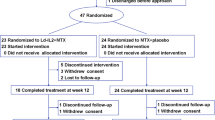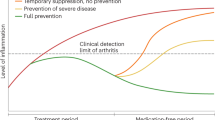Abstract
Recent data have shown that disability and joint destruction in rheumatoid arthritis (RA) occur early on in the course of the disease and progress rapidly. It has been shown that in the early stages of RA, disability is attributed to increased disease activity, whereas later in the course of the disease, disability results from irreversible joint damage. These findings support the need to develop treatment strategies that will rapidly bring the disease under control, with the ultimate goal of alleviating symptoms and halting progressive joint damage. A number of such strategies have been evaluated, including the early administration of a biologic agent alone or in combination with high-dose methotrexate. Other, more recent treatment strategies include the tight control of disease activity by targeting specific outcomes necessary for decision making; the use of biologic agents for the treatment of moderate disease; and the induction of remission with a biologic agent early in the course of disease, followed by maintenance therapy using a conventional disease-modifying antirheumatic drug. The substantial positive effect these strategies have on patient outcomes supports the concept that the optimal management of RA involves aggressive early therapy combined with close monitoring of disease progression and modification of ineffective therapeutic strategies.
Key Points
-
Early use of biologic agents is more effective than use later in disease
-
Combination treatment with a biologic agent and methotrexate is more effective than either alone
-
Patients with moderate disease have better outcomes after treatment than patients with severe disease
-
Intensive therapy with dose monitoring and adjustments in therapy (tight control) is more effective than routine care
This is a preview of subscription content, access via your institution
Access options
Subscribe to this journal
Receive 12 print issues and online access
$209.00 per year
only $17.42 per issue
Buy this article
- Purchase on Springer Link
- Instant access to full article PDF
Prices may be subject to local taxes which are calculated during checkout


Similar content being viewed by others
References
Lee DM and Weinblatt ME (2001) Rheumatoid arthritis. Lancet 358: 903–911
van der Heijde DM et al. (1995) Radiographic progression on radiographs of hands and feet during the first 3 years of rheumatoid arthritis measured according to Sharp's method (van der Heijde modification). J Rheumatol 22: 1792–1796
Lard LR et al. (2001) Early versus delayed treatment in patients with recent-onset rheumatoid arthritis: comparison of two cohorts who received different treatment strategies. Am J Med 111: 446–451
McQueen FM et al. (1998) Magnetic resonance imaging of the wrist in early rheumatoid arthritis reveals a high prevalence of erosions at four months after symptom onset. Ann Rheum Dis 57: 350–356
Conaghan PG et al. (2003) Elucidation of the relationship between synovitis and bone damage: a randomized magnetic resonance imaging study of individual joints in patients with early rheumatoid arthritis. Arthritis Rheum 48: 64–71
Ostergaard M et al. (2005) Imaging in early rheumatoid arthritis: roles of magnetic resonance imaging, ultrasonography, conventional radiography and computed tomography. Best Pract Res Clin Rheumatol 19: 91–116
Geletka R and St Clair EW (2003) Treatment of early rheumatoid arthritis. Best Pract Res Clin Rheumatol 17: 791–809
Breedveld FC et al. (2004) Infliximab in active early rheumatoid arthritis. Ann Rheum Dis 63: 149–154
Genovese MC et al. (2002) Etanercept versus methotrexate in patients with early rheumatoid arthritis: two-year radiographic and clinical outcomes. Arthritis Rheum 46: 1443–1450
Klareskog L et al. (2004) Therapeutic effect of the combination of etanercept and methotrexate compared with each treatment alone in patients with rheumatoid arthritis: double-blind randomised controlled trial. Lancet 363: 675–681
Gibofsky A et al. (2006) Real-world utilization of DMARDs and biologics in rheumatoid arthritis: the RADIUS (Rheumatoid Arthritis Disease-Modifying Anti-Rheumatic Drug Intervention and Utilization Study) study. Curr Med Res Opin 22: 169–183
Bathon JM and Genovese MC (2003) The Early Rheumatoid Arthritis (ERA) trial comparing the efficacy and safety of etanercept and methotrexate. Clin Exp Rheumatol 21: S195–S197
Breedveld FC et al. (2006) The PREMIER study: A multicenter, randomized, double-blind clinical trial of combination therapy with adalimumab plus methotrexate versus methotrexate alone or adalimumab alone in patients with early, aggressive rheumatoid arthritis who had not had previous methotrexate treatment. Arthritis Rheum 54: 26–37
Baumgartner SW et al. (2004) Etanercept (Enbrel) in patients with rheumatoid arthritis with recent onset versus established disease: improvement in disability. J Rheumatol 31: 1532–1537
Taylor PC et al. (2006) Ultrasonographic and radiographic results from a two-year controlled trial of immediate or one-year-delayed addition of infliximab to ongoing methotrexate therapy in patients with erosive early rheumatoid arthritis. Arthritis Rheum 54: 47–53
Keystone E et al. (2003) Response to adalimumab in patients with early versus late rheumatoid arthritis [abstract THU0201]. Annual European Congress of Rheumatology 2003 June 18–21, Lisbon, Portugal
St Clair EW et al. (2004) Combination of infliximab and methotrexate therapy for early rheumatoid arthritis: a randomized, controlled trial. Arthritis Rheum 50: 3432–3443
Smolen JS et al. (2006) Predictors of joint damage in patients with early rheumatoid arthritis treated with high-dose methotrexate with or without concomitant infliximab: results from the ASPIRE trial. Arthritis Rheum 54: 702–710
Klareskog L et al. (2004) Therapeutic response following two years of treatment with etanercept, methotrexate, or combination therapy in patients with early rheumatoid arthritis [abstract]. Arthritis Rheum 50 (Suppl): S238–S239
Smolen JS et al. (2006) Infliximab treatment maintains employability in patients with early rheumatoid arthritis. Arthritis Rheum 54: 716–722
Weinblatt ME et al. (2006) Long term efficacy and safety of adalimumab plus methotrexate in patients with rheumatoid arthritis: ARMADA 4 year extended study. Ann Rheum Dis 65: 753–759
van der Heijde D et al. (2006) Patient reported outcomes in a trial of combination therapy with etanercept and methotrexate for rheumatoid arthritis: the TEMPO trial. Ann Rheum Dis 65: 328–334
van der Heijde D et al. (2006) Comparison of etanercept and methotrexate, alone and combined, in the treatment of rheumatoid arthritis: Two-year clinical and radiographic results from the TEMPO study, a double-blind, randomized trial. Arthritis Rheum 54: 1063–1074
Schiff MH et al. (2004) Induction of long-term remission in patients with rheumatoid arthritis treated with adalimumab (Humira) plus methotrexate [abstract FRI0158]. Annual European Congress of Rheumatology 2004 June 9–12, Berlin, Germany
Keystone E et al. (2005) Comparison of efficacy responses to etanercept treatment in rheumatoid arthritis patients with moderate versus severe disease. Ann Rheum Dis 64: 180
Keystone EC et al. (2004) Subgroup analysis of radiographic progression in RA patients with moderate disease treated with adalimumab (Humira) [abstract FRI0064]. European League Against Rheumatism 2004 June 9–12, Berlin, Germany
Grigor C et al. (2004) Effect of a treatment strategy of tight control for rheumatoid arthritis (the TICORA study): a single-blind randomised controlled trial. Lancet 364: 263–269
Goekoop-Ruiterman YP et al. (2005) Clinical and radiographic outcomes of four different treatment strategies in patients with early rheumatoid arthritis (the BeSt study): A randomized, controlled trial. Arthritis Rheum 52: 3381–3390
Boers M et al. (1997) Randomised comparison of combined step-down prednisolone, methotrexate and sulphasalazine with sulphasalazine alone in early rheumatoid arthritis. Lancet 350: 309–318
Verstappen SM et al. (2004) Aiming for remission; computer-assisted management of early rheumatoid arthritis: CAMERA. American College of Rheumatology Annual Scientific Meeting 2004 October 16–21, San Antonio, USA
Quinn MA et al. (2005) Very early treatment with infliximab in addition to methotrexate in early, poor-prognosis rheumatoid arthritis reduces magnetic resonance imaging evidence of synovitis and damage, with sustained benefit after infliximab withdrawal: results from a twelve-month randomized, double-blind, placebo-controlled trial. Arthritis Rheum 52: 27–35
Van der Bijl A et al. (2005) Many early rheumatoid arthritis patients with a good clinical response to infliximab can discontinue anti-TNF-alpha therapy without relapse [abstract OP0010]. Ann Rheum Dis 64 (Suppl 3): S59
Acknowledgements
The author wishes to thank Nadine Daneman and Correna LeCoure for their excellent administrative assistance, and Rick Davis, MS, RPh, whose work was funded by Amgen Inc, for providing editorial assistance in the preparation of this manuscript.
Author information
Author notes
EC Keystone is a Professor of Medicine at the University of Toronto, a Senior Consultant in Rheumatology at Mount Sinai Hospital, and the Chairman of the Canadian Rheumatology Research Consortium in Toronto. He is the Director of The Rebecca MacDonald Centre for Arthritis and Autoimmune Disease, and heads the Advanced Therapeutics Division, in Toronto, Ontario, Canada
- Edward C Keystone
Ethics declarations
Competing interests
The author has conducted research for the following companies: Amgen, Bristol-Myers Squibb, Centocor Inc, Hoffman-La Roche Ltd (Canada), Abbott laboratories, Novartis, Schring Plough Inc., Targeted Genetics, Therakos, Wyeth Pharmaceuticals.
The author has acted as a Consultant or a member of the Advisory Board for the following companies: Abbott Laboratories, Amgen, Aventis Pharma, Bristol-Myers Squibb, Celltech, Centocor Inc., Genentech, Hoffman La-Roche Ltd, Schring Plough Inc., Targeted Genetics, Wyeth Ayerst, Genentech.
The author is a Speaker for the following companies: Abbott Laboratories, Amgen, Aventis Pharma, Centocor Inc., Genentech, hoffman-La Roche Ltd, Schering Plough Inc, Wyeth.
Rights and permissions
About this article
Cite this article
Keystone, E. Strategies to control disease in rheumatoid arthritis with tumor necrosis factor antagonists—an opportunity to improve outcomes. Nat Rev Rheumatol 2, 594–601 (2006). https://doi.org/10.1038/ncprheum0340
Received:
Accepted:
Issue Date:
DOI: https://doi.org/10.1038/ncprheum0340
This article is cited by
-
Increased occurrence of cardiovascular events and comorbidities in a general rheumatology cohort
Irish Journal of Medical Science (2010)
-
Novel strategies for the treatment of inflammatory hyperalgesia
European Journal of Clinical Pharmacology (2010)
-
DAS-28-based EULAR response and HAQ improvement in rheumatoid arthritis patients switching between TNF antagonists
BMC Musculoskeletal Disorders (2009)



